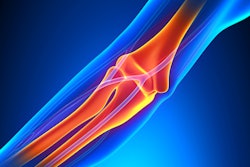
Ultrasound elastography is a relatively new technology that can noninvasively assess liver stiffness, a key component when evaluating the severity of liver fibrosis. But because insurer coverage tends to be variable, it's not in mainstream clinical use, according to a study in the November issue of the Journal of the American College of Radiology.
So is it worth investing in ultrasound elastography? Maybe, wrote a team led by Dr. Courtney Moreno from Emory University in Atlanta. Emory's radiology department began offering the exam at the request of the hospital's hepatologists, who were being required by some regional insurers to provide an elastography score before preauthorizing payments for hepatitis C medications.
"We experienced a brisk demand for liver ultrasound elastography with imaging after we began offering this service line ... [although we] found coverage by both public and private payors quite variable," Moreno and colleagues wrote.
Clinical advantage
One of elastography's advantages for assessing fibrosis severity is that multiple areas of the liver can be sampled without the risks associated with liver biopsy, which can sample only one area at a time, they wrote. The technique is billed under a category III current procedural terminology (CPT) code -- a category that is used for new and emerging technology and may or may not be reimbursed, Moreno and colleagues noted (JACR, November 2017, Vol. 14:11, pp. 1426-1428).
Emory began offering ultrasound elastography at its largest practice location in 2015, and the researchers decided to examine denial rates for this new service line to gather information about whether it would be financially feasible to expand it to other locations.
Emory's radiology department performed an average of 22 ultrasound elastography studies per month between August 2015 and December 2016. Most patients (92%) were referred by Emory's hepatology practice; the remainder was referred by regional hepatologists and infectious disease physicians not necessarily affiliated with Emory, as well as other types of clinicians in Emory's system.
Of the total studies performed, 10% were reimbursed in 2015 and 17% were reimbursed in 2016 -- much lower rates than the percentages of complete or limited abdominal ultrasound exams reimbursed during the same interval at the same imaging center.
| Percent payor coverage of elastography vs. other US exams | ||
| Study type | 2015 | 2016 |
| Elastography | 10% | 17% |
| Abdomen, complete | 78% | 81% |
| Abdomen, limited | 77% | 79% |
| Percent coverage of elastography vs. other US exams by payor | |||||
| Study type | PPO | Blue Cross | HMO | Medicare | Medicaid |
| Elastography | 100% | 22% | 13% | 18% | 12% |
| Abdomen, complete | 89% | 84% | 65% | 95% | 94% |
| Abdomen, limited | 89% | 86% | 70% | 95% | 91% |
"We weren't expecting the reimbursement rate to be as low as it was, but it did increase over the study's time frame -- which can happen with new technologies billed under category III CPT codes," Moreno told AuntMinnie.com. "And practices should keep in mind that even though elastography's reimbursement varied, it is an add-on code to abdominal studies, which are reimbursed."
Worth the investment?
The fact that hepatologists have been the drivers for offering ultrasound elastography is also unusual, according to the researchers.
 Dr. Courtney Moreno from Emory University.
Dr. Courtney Moreno from Emory University."The persistent requests from our hepatology colleagues to begin offering ultrasound elastography with diagnostic imaging were unique compared with our experience with other nascent ultrasound technologies," they wrote. "[For other technologies,] implementation has been primarily driven by radiologist interest rather than clinical demand."
Under fee-for-service payment models, ultrasound elastography may not be viable for many practices due to the current low coverage rates, according to Moreno's group: The cost of upgrading an existing ultrasound unit to elastography capability can range from $10,000 to $15,000 per machine. But it's important to consider downstream effects.
"In capitated and value-based payment models, use of elastography with diagnostic imaging has the potential to lower costs if elastography scores are used in place of liver biopsy to establish the severity of liver fibrosis," the researchers wrote. "Additionally, there is no risk of complication as a result of the elastography procedure itself, and liver biopsy is associated with up to a 5% rate of significant bleeding."
And referring physician satisfaction may be an additional benefit to offering ultrasound elastography, even if reimbursement is variable, they concluded.
"Given the current healthcare payment climate, radiology practices should carefully consider reasons other than coverage rates (e.g., referring physician satisfaction) if considering offering ultrasound elastography," they wrote. "If ultrasound elastography follows precedent by other emerging imaging technologies, coverage could expand in the future."




















